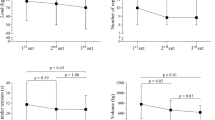Abstract
Observations on 1 282 measurements of non-invasive cardiovascular reflex testing of autonomic function in 1 023 control subjects and patients with different disorders are presented. It is suggested that the Valsalva manoeuvre be performed three times rather than once and the highest Valsalva ratio should be used instead of the mean or first of the three ratios. The deep breathing test gives equally reliable information when three breathing cycles are used instead of six. Symptoms were detected in up to 15% of the subjects depending on the test, although the majority of these were minor and transient. The frequency of ventricular/supraventricular extrasystoles increased especially during the Valsalva manoeuvre (+67%/+40%) and post-strain (+49%/+25%) phases and early recovery phase of the orthostatic test (+69%/+156%) and to a lesser degree during deep breathing (+18%/+50%) and handgrip (+36%/-11%) phases compared with the resting phase. However, severe cardiac rhythm disturbances were very rare. 1–2% of the younger (<50 years) and 10% of the older subjects were not able to perform the tests adequately. The R-R intervals on which the results are based should be selected carefully, and use of a continuous non-invasive method of blood pressure monitoring should provide further useful information.
Similar content being viewed by others
References
Consensus Statement. Report and recommendations of the San Antonio conference on diabetic neueropathy.Diabetes 1988;37: 1000–1004.
Ewing DJ. Recent advances in the non-invasive investigation of diabetic autonomic neuropathy. In: Bannister R, ed.Autonomic failure. A textbook of clinical disorders of the autonomic nervous system. 2nd edn. Oxford: Oxford Medical Publications, 1988: 667–689.
Mustonen J, Länsimies E, Uusitupa M, Talwar S, Hyödynmaa S, Kärkkäinen A. Testing of autonomic cardiovascular regulation— methodological considerations.Clin Physiol 1989;9: 249–257.
Ryder REJ, Hardisty CA. Which battery of cardiovascular autonomic function tests?Diabetologia 1990;33: 177–179.
Ewing DJ. Which battery of cardiovascular autonomic function tests? (Comment)Diabetologia 1990;33: 180–181.
Wieling W, van Lieshaut JJ. The assessment of cardiovascular reflex activity: standardization is needed.Diabetologia 1990;33: 182–183.
Eckberg DL. Parasympathetic cardiovascular control in human disease: a critical review of methods and results.Am J Physiol 1980;239: H581-H593.
Vargas E, Lye M. The assessment of autonomic function in the elderly.Age Ageing 1980;9: 210–214.
Kaijser L. Autonomic nerve function tests—need for standardization?Clin Physiol 1986;6: 475–479.
Piha SJ. Cardiovascular autonomic reflex tests: normal responses and age-related reference values.Clin Physiol 1991;11: 277–290.
Piha SJ, Puukka P, Seppänen A. Short- and long-term reproducibility of cardiovascular tests of autonomic function in normal subjects.Clin Auton Res 1991;1: 115–118.
Helfant RH, deVilla MA, Meister SG. Effect of sustained isometric handgrip exercise on left ventricular performance.Circulation 1971;44: 982–993.
Fisher ML, Nutter DO, Jacobs W, Schlant RC. Haemodynamic responses to isometric exercise (handgrip) in patients with heart disease.Br Heart J 1973;35: 422–432.
Gorlin R, Knowles JH, Storey CCF. The Valsalva manoeuvre as a test of cardiac function. Pathologic physiology and clinical significance.Am J Med 1957;22: 197–212.
Matikainen E. Diabetic neuropathy. Clinical, electrophysiological and histopathological studies. Academic dissertation. Helsinki: University of Helsinki, Department of Neurology and Institute of Occupational Health, 1982.
Ewing DJ. Practical bedside investigation of diabetic autonomic failure. In: Bannister R, ed.Autonomic failure. A textbook of clinical disorders of the autonomic nervous system. Oxford: Oxford University Press, 1983: 371–405.
Author information
Authors and Affiliations
Rights and permissions
About this article
Cite this article
Piha, S.J., Seppänen, A. Observations based on 10-years'experience of non-invasive cardiovascular reflex testing of autonomic function from a rehabilitation research centre. Clinical Autonomic Research 1, 289–296 (1991). https://doi.org/10.1007/BF01819834
Received:
Accepted:
Issue Date:
DOI: https://doi.org/10.1007/BF01819834




